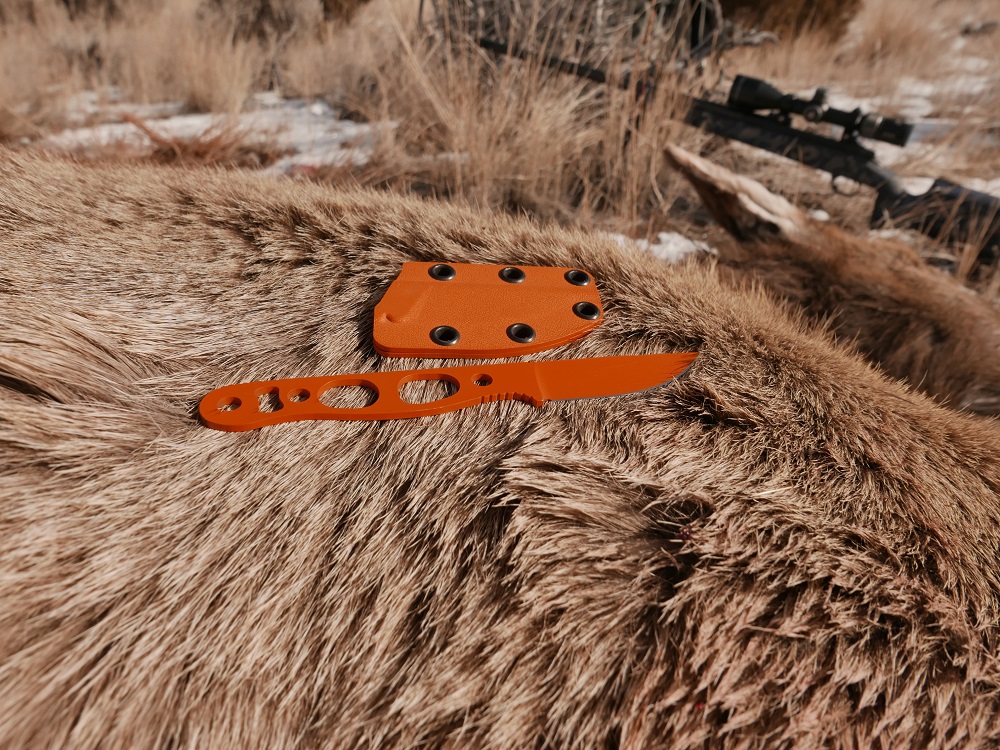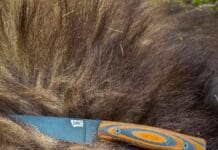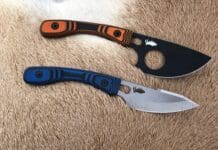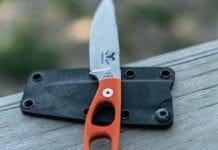As a weight conscious backpack hunter, I scrutinize everything in my pack including the weight of the game bags, extra cord, and knives in my kill kit. It’s taken years, but I’ve refined and selected equipment optimized for my style of hunting. Occasionally a piece of gear comes along with the potential to replace or improve my existing system.

Argali Col Knife
I tested one such item this early winter: an ultralight fixed blade knife. The Argali Col knife is a blade designed for hunters who are mindful of every once carried into the backcountry. Weighing 1.8 ounces with the Kydex sheath (1.1 ounces without), the Col has a skeletonized handle with serrated touchpoints along the knife’s spine, butt, and finger notch. The blade is 2.45 inches long with an overall knife length of 6.25 inches. It is treated in orange Cerakote for high visibility and further corrosion resistance. Learn more here.
High Quality Steel
The metal in the entire Argali knife line uses S35VN steel, which is considered by many to be the best all-around steel for knife blades. I did an internet dive on this particular blend of steel and found jargon such as longitudinal toughness, transverse toughness, chip resistance, Rockwell Hardness, and side-load stress; all of which this type of steel rates particularly well in. In simple terms, this blade has great edge retention and won’t chip or easily corrode.

Field Testing The Argali Col Knife
I had the opportunity to use the knife on a late January 2021 cow elk hunt in Montana where the weather was cold. Despite the cold, I was able to break down the elk with bare hands and found that the skeletonized grip was not slippery and the serrated touchpoints were optimally located. For precision control of the blade, I used forward serration most as it offered my index finger command of the working edge of the knife.
Great For Caping
This knife would really shine in precision tasks like caping. The small blade and finger-forward control would allow for incredibly precise cuts into tear ducts, around antler bases, and lips. It would also work really well skinning the knuckles of a bear paw or hooves and legs of life-size sheep or goats.

Ideal For Small to Midsize Animals
The Argali Col would also shine when breaking down smaller size game such as mule deer and blacktail deer. However, breaking down an entire cow elk is a bit much for this knife. The 2.5-inch blade is on the small side for skinning, quartering, and deboning an animal this large. I had to take an inordinate amount of knife strokes to get the job done on this size class of animal. I’ve butchered many elk in the field and prefer a blade in the 3.5-to-4-inch range.
Edge Retention
The edge has maintained its hair-shaving sharpness over time despite cutting through joints and thick hide. The 20-degree edge angle is easy to touch up on my Work Sharp sharpener, although Argali offers a lifetime of free sharpening for those who want a factory edge restored to the knife.

Conclusion
Has the Argali Col Knife found permanent status in my kill kit? It has but not as a do-it-all knife. The lightweight design, edge retention, and precise handling make it a perfect partner to a longer bladed skinning/boning knife. It will shine when it comes time to remove a cape, and with its scanty weight, I will never even know it’s in my pack until needed.
You can purchase the Col on the Argali website for $179. While you are there check out the other knife options available to fit your needs, and pick up some game bags.
Join Josh for questions or comments here.
Jordan Budd also reviewed the Argali Carbon Knife here.




















